
Dasiphora fruticosa is a species of hardy deciduous flowering shrub in the family Rosaceae, native to the cool temperate and subarctic regions of the northern hemisphere, often growing at high altitudes in mountains. Dasiphora fruticosa is still widely referenced in the horticultural literature under its synonym Potentilla fruticosa. Common names include shrubby cinquefoil, golden hardhack, bush cinquefoil, shrubby five-finger, widdy, and kuril tea.

The golden-fronted woodpecker is a species of bird in subfamily Picinae of the woodpecker family Picidae. It is found in the southern United States, Mexico and parts of Central America.

Quercus durata, commonly known as leather oak, is a species of oak endemic to California, common in the Coast Ranges and the foothills of the Sierra Nevada. The common name "leather oak" is derived from the leathery texture on the lop of its leaves. Taxonomically it is placed in the white oak group.

Roemeria argemone is a species of flowering plant in the poppy family Papaveraceae. Its common names include long pricklyhead poppy, prickly poppy and pale poppy. Its native range includes parts of Eurasia and North Africa, but it can be found growing wild in parts of North America, where it is an introduced species. It is cultivated as an ornamental plant.

The green-tailed emerald is a species of hummingbird in the "emeralds", tribe Trochilini of subfamily Trochilinae. It is endemic to Venezuela.

The dusky hummingbird is a species of hummingbird in the "emeralds", tribe Trochilini of subfamily Trochilinae. It is endemic to Mexico.

The black-thighed puffleg is a species of hummingbird in the "brilliants", tribe Heliantheini in subfamily Lesbiinae. It is found in Colombia and Ecuador.
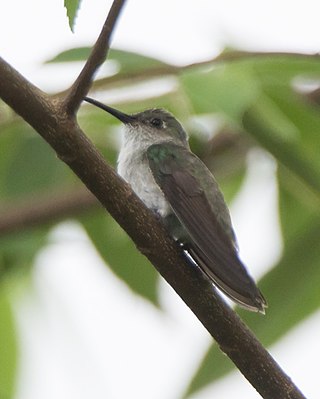
The olive-spotted hummingbird is a species of hummingbird in the "emeralds", tribe Trochilini of the subfamily Trochilinae. It is found in Brazil, Colombia, Ecuador, and Peru.

The purple-backed thornbill is a species of hummingbird in the "coquettes", tribe Lesbiini of subfamily Lesbiinae. It is found in Bolivia, Colombia, Ecuador, Peru, and Venezuela.
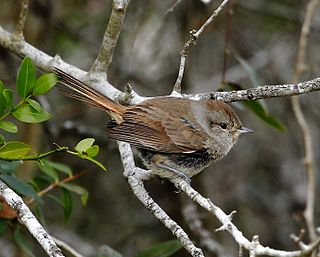
The short-billed canastero is a species of bird in the Furnariinae subfamily of the ovenbird family Furnariidae. It is found in Argentina, Bolivia, Brazil, Paraguay, and Uruguay.
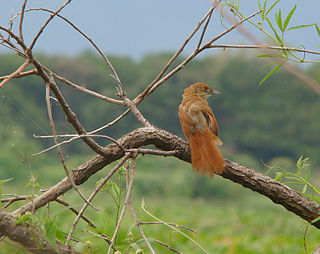
The greater thornbird is a species of bird in the Furnariinae subfamily of the ovenbird family Furnariidae. It is found in Argentina, Bolivia, Brazil, Paraguay, and Uruguay.

The big-headed pantanal swamp turtle or pantanal swamp turtle is a species of turtle in the family Chelidae found in Brazil, Bolivia, Argentina, and Paraguay.
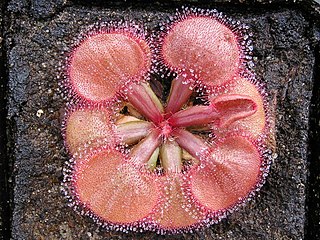
Drosera falconeri is a carnivorous plant in the genus Drosera. It is endemic to the Northern Territory of Australia.

Ribes canthariforme is a rare species of currant commonly known as the Moreno currant. It is characterized by pink to red flowers, a dense inflorescence, and a lack of nodal spines. A little-known endemic to the mountains of San Diego County, it is usually found growing the shade of massive boulders in the chaparral. Although the rarity and small numbers of this plant is a conservation concern, it is usually found in remote areas and is well hidden enough to be safe from most threats.

Mycena aurantiomarginata, commonly known as the golden-edge bonnet, is a species of agaric fungus in the family Mycenaceae. First formally described in 1803, it was given its current name in 1872. Widely distributed, it is common in Europe and North America, and has also been collected in North Africa, Central America, and Japan. The fungus is saprobic, and produces fruit bodies (mushrooms) that grow on the floor of coniferous forests. The mushrooms have a bell-shaped to conical cap up to 2 cm in diameter, set atop a slender stipe up to 6 cm long with yellow to orange hairs at the base. The fungus is named after its characteristic bright orange gill edges. A microscopic characteristic is the club-shaped cystidia that are covered with numerous spiky projections, resembling a mace. The edibility of the mushroom has not been determined. M. aurantiomarginata can be distinguished from similar Mycena species by differences in size, color, and substrate. A 2010 publication reported the discovery and characterization of a novel pigment named mycenaaurin A, isolated from the mushroom. The pigment is responsible for its color, and it has antibiotic activity that may function to prevent certain bacteria from growing on the mushroom.
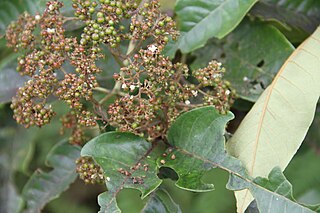
Harungana madagascariensis is a flowering plant found in Madagascar that is commonly known as the dragon's blood tree, orange-milk tree or haronga.

Ximenia caffra, the sourplum, is a small tree or small shrub that is thinly branched. It is part of the Olacaceae family which is native throughout tropical regions. In particular, the sourplum is native to regions in South East Africa, mainly Botswana, Kenya, Malawi, Mozambique, South Africa, Tanzania, Uganda, Zambia, and Zimbabwe. The sourplum tree produces several fruits on an annual basis. These are generally sour with a dry aftertaste, and they contain significant amounts of potassium. The tree itself is fairly hardy, with frost resistance and drought tolerance. The tree, fruit, seed, leaves, and roots are all used for human consumption, medicinally, or for fuel. The trees themselves can also be used as natural land division barriers.

Barberetta is a genus of herbaceous perennial plants in the family Haemodoraceae. It contains only one known species, Barberetta aurea.

Dudleya anomala is a rare species of succulent plant in the family Crassulaceae commonly known as the Todos Santos liveforever. With a dense, cushion-forming habit, this leaf succulent is characterized by elongated stems, slightly sticky leaves, and bell-shaped flowers with white, spreading petals. This species is native to Baja California, Mexico, and is found primarily on islands and one coastal locality.
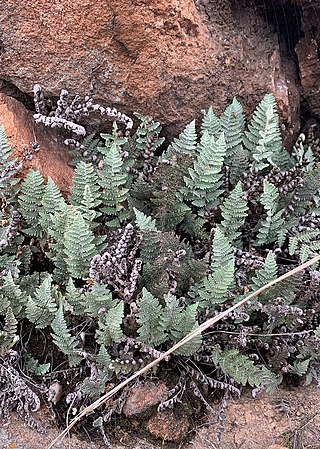
Myriopteris lindheimeri, formerly known as Cheilanthes lindheimeri, is a species of fern in the Pteridaceae family with the common name fairy swords.



















